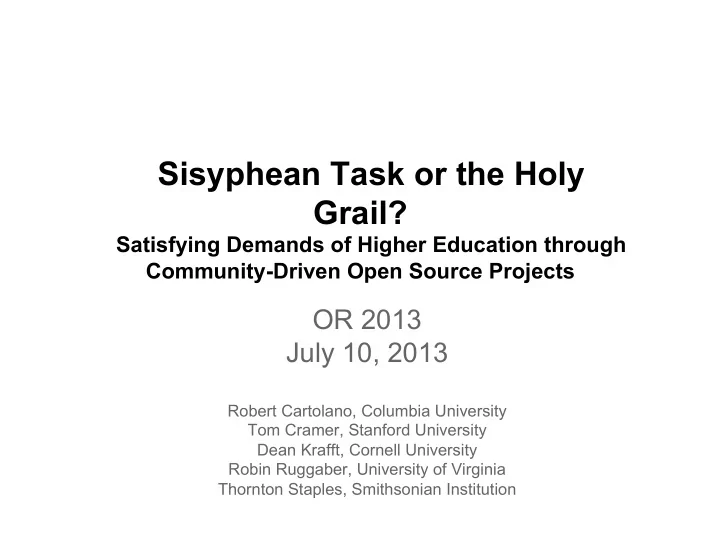

Sisyphean Task or the Holy Grail? Satisfying Demands of Higher Education through Community-Driven Open Source Projects OR 2013 July 10, 2013 Robert Cartolano, Columbia University Tom Cramer, Stanford University Dean Krafft, Cornell University Robin Ruggaber, University of Virginia Thornton Staples, Smithsonian Institution
Session • Overview • Panelist Introductions • Questions for the Panel o Community-Driven - a model for success? o Level of Governance - small, medium, large? o Does size and complexity make a difference? o What are Lessons Learned? • Q & A
What is Community Driven Development? In a community-source project, a consortium of colleges and universities comes together to build software needed by each of them, contributing resources to a virtual organization that serves as a software development shop. Challenges and Opportunities of Open Source in Higher Education Fuchs, I, 2007
Community Source Model The Community Source Model is a hybrid model that blends elements of directed development...and the openness of traditional open-source projects like Apache. The distinguishing feature of the Community Source Model is that many of the investments of developers’ time, design, and project governance come from institutional contributions by colleges, universities, and some commercial firms rather than from individuals. Open Source 2010: Reflections on 2007 Wheeler, B. Educause, Jan. Feb. 2007
Why Work Together? "Conditions in technology, economics, and expanding service requirements demand a more radical approach to collaboration." "Advancing From Kumbaya to Radical Collaboration: Redefining the Future Research Library" Neal, J., Journal of Library Administration, 2011. • Goals Align • Shared Resources • Shared Values • Sustainability and Cooperation Over Time "Marketecture of Community" Hilton, Wheeler, Educause 11-12/2012
How are Community Driven Projects Organized? • Primordial Origins - single institution or community driven by design • Motivation o "nature abhors a vacuum" o pain threshold • Number of Committers • Number and type of participating organizations • User Engagement • Governance Level • Size and Complexity • Maintenance, Growth, Sustainability
Community-Driven Projects/Groups
Several Such Efforts & Our Panelists Fedora • Thorny Staples, Smithsonian Institution • Fedora (Flexible Extensible Digital Object Repository Architecture) is developed as an architecture for storing, managing, and accessing digital content in the form of digital objects. Fedora defines a set of abstractions for expressing digital objects, asserting relationships among digital objects, and linking "behaviors" (i.e., services) to digital objects. Hydra • Tom Cramer, Stanford University • Hydra is a repository solution that is being used to provide access to their digital content. Hydra provides a versatile and feature rich environment for end-users and repository administrators alike. VIVO • Dean Krafft, Cornell University • A semantic-web-based research-focused discovery tool that enables collaboration among researchers and scholars across all disciplines. Browse or search linked open data on people, departments, courses, grants, and publications .
Community Driven - A Model for Success? Panelist Question: Why did you choose community-driven development? At what stage did you decide to go with community-driven development?
Levels of Governance Panelist Question: Does one size fit all? How is your community governed now, has governance changed over time and if so what factors drove that change?
Does Size and Complexity Matter? Panelist Question: Has size and complexity of your community, competing needs and technology impacted the community effort and if so, how? How does these issues relate to success if at all?
Lessons Learned Panelist Question: What lessons have been learned that can be shared with other community-driven projects?
Q & A
References The Marketecture of Community , Wheeler, Bradley and Hilton, James L., Educause Review, 11/1/2012, http:// www.educause.edu/ero/article/marketecture-community Advancing from Kumbaya to Radical Collaboration: Redefining the Future Research Library , Neal, James, Journal of Library Administration, 1/2011, http://hdl.handle.net/10022/AC:P:20919 "Challenges and Opportunities of Open Source in Higher Education", Fuchs, Ira, The Tower and the Cloud, Educause, 2008, pp. 150-157, http://net.educause.edu/ir/library/pdf/pub7202.pdf Community: The Structure of Belonging , Block, Peter, Berret-Koehler Publishers, 2008 Open Source 2010: Reflections on 2007 , Wheeler, Bradley, Educause Review, 1/1/2007, http://www.educause.edu/ero/ article/open-source-2010-reflections-2007 Open Source 2007: How Did This Happen? , Wheeler, Bradley, Educause Review, 7/1/2004, http://www.educause.edu/ ero/article/open-source-2007-how-did-happen The Open-Source Movement , Warger, Thomas A., Educause Review, 1/1/2002, http://www.educause.edu/ero/article/ open-source-movement Stewardship: Choosing service over self-interest, Block, Peter, Berrett-Koehler Publishers, 1993
Recommend
More recommend